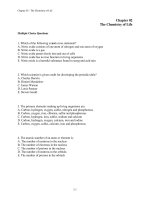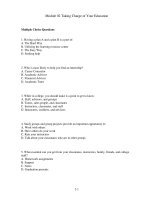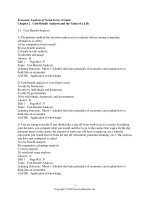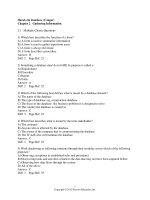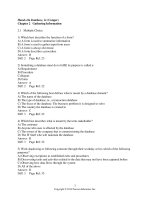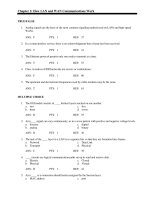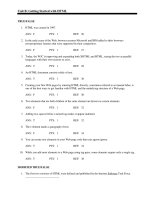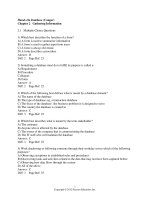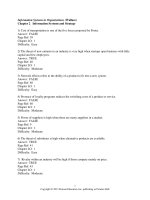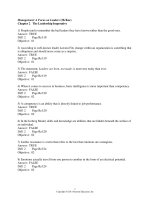Hands on database 1st edition steve conger test bank
Bạn đang xem bản rút gọn của tài liệu. Xem và tải ngay bản đầy đủ của tài liệu tại đây (71.69 KB, 15 trang )
Hands-On Database (Conger)
Chapter 2 Gathering Information
2.1 Multiple-Choice Questions
1) Which best describes the function of a form?
A) A form is used to summarize information
B) A form is used to gather input from users
C) A form is always electronic
D) A form describes a procedure
Answer: B
Diff: 2 Page Ref: 23
2) Something a database must do to fulfill its purpose is called a:
A) Requirement
B) Procedure
C) Report
D) Form
Answer: A
Diff: 2 Page Ref: 22
3) Which of the following best defines what is meant by a database domain?
A) The name of the database
B) The type of database, eg, a transaction database
C) The focus of the database the business problem it is designed to solve
D) The country the database is created in
Answer: C
Diff: 3 Page Ref: 22
4) Which best describes what is meant by the term stakeholder?
A) The customer
B) Anyone who is affected by the database
C) The owner of the company that is commissioning the database
D) The IT staff who will maintain the database
Answer: C
Diff: 3 Page Ref: 22
5) Work shadowing or following someone through their workday serves which of the following
purposes?
A) Observing exceptions to established rules and procedures
B) Discovering tasks and activities related to the data that may not have been captured before
C) Observing how data flows through the system
D) All of the above
Answer: C
Diff: 3 Page Ref: 35
1
Copyright © 2012 Pearson Education, Inc.
6) A document that summarizes and displays data is called a:
A) Report
B) Procedure
C) Form
D) Requirement
Answer: A
Diff: 2 Page Ref: 23
7) Which of the following best describes the type of document known as a procedure?
A) A document that summarizes and displays data
B) A document that outlines the approved steps for completing a business process
C) A document that gathers user input
D) A document that describes an organization's organizational structure
Answer: B
Diff: 2 Page Ref: 23
8) Which of the following is a type of database optimized for processing transactions in real
time?
A) Business intelligence
B) Transaction processing system
C) Management information system
D) Data warehouse
Answer: B
Diff: 1 Page Ref: 27
9) Which of the following is a database optimized to produce summary reports for management
needs?
A) Business intelligence
B) Transaction processing system
C) Management information system
D) Data warehouse
Answer: C
Diff: 2 Page Ref: 27
10) Which of the following is a set of tools for analyzing trend and patterns in business data?
A) Business intelligence
B) Transaction processing system
C) Management information system
D) Data warehouse
Answer: A
Diff: 2 Page Ref: 27
2
Copyright © 2012 Pearson Education, Inc.
11) Which of the following is a collection of various data sources including documents used for
data mining?
A) Business intelligence
B) Transaction processing system
C) Management information system
D) Data warehouse
Answer: D
Diff: 3 Page Ref: 27
12) Which of the following describes common uses of XML?
A) File format for documents
B) Data transfer
C) Both A and B
D) None of the above
Answer: C
Diff: 3 Page Ref: 27
13) What is a question that does not have a fixed answer called?
A) A close ended question
B) An open ended question
C) A confusing question
D) None of the above
Answer: B
Diff: 2 Page Ref: 28
14) Which of the following represents best practices for interviews?
A) Prepare questions beforehand
B) Have someone other than the interviewer take notes
C) Keep participants on task
D) All of the above
Answer: D
Diff: 2 Page Ref: 28-29
15) Interviews are good for asking what kind of questions?
A) Open ended questions
B) Close ended questions
C) A confusing question
D) None of the above
Answer: A
Diff: 2 Page Ref: 28
3
Copyright © 2012 Pearson Education, Inc.
16) When interviewing stakeholders about a new database, you may find some people resistant
to the proposed changes. Which of the following represents the best practice for dealing with
them?
A) Dismiss their concerns and focus on the requirements
B) Refer them to their supervisor
C) Listen to their concerns. They may have valid reasons for feeling as they do.
D) Reassure them that it will all turn out for the best
Answer: C
Diff: 3 Page Ref: 31
17) A question that has a fixed answer or a fixed set of answers is called:
A) An open ended question
B) A technical question
C) A closed question
D) A questionnaire
Answer: C
Diff: 2 Page Ref: 32
18) Multiple choice questions are good examples of what kind of question?
A) An open ended question
B) A closed question
C) A technical question
D) A questionnaire
Answer: B
Diff: 2 Page Ref: 32
19) Which of the following is a disadvantage of a questionnaire?
A) It is harder to evaluate the honesty of the response
B) They are more expensive than interviews
C) They are harder to summarize than interviews
D) B and C
Answer: A
Diff: 3 Page Ref: 32
20) Which of the following best defines the term exception?
A) An error in the system
B) Something the system does not deal with
C) A violation of rules
D) A variation on how things are done or recorded, an alternative process
Answer: D
Diff: 2 Page Ref: 22
4
Copyright © 2012 Pearson Education, Inc.
21) Which of the following best defines the term requirement?
A) Something a database must do to fulfill its purpose
B) A rule about database structure
C) A business procedure
D) The topic of the database
Answer: A
Diff: 2 Page Ref: 22
22) If you encounter a term or abbreviation in a form that you don't understand, you should:
A) Take a guess at its meaning and move on
B) Assume it is not important
C) Make sure you ask until the term is clarified
D) Make a mental note to pursue it sometime later
Answer: C
Diff: 3 Page Ref: 23
23) When determining who to interview, you should:
A) Only interview the managers and people in charge
B) Interview everyone who has a stake in the database
C) Only interview the IT staff who will maintain the database
D) Interview whoever is most available at the time
Answer: B
Diff: 2 Page Ref: 22
24) Which of the following is a term that refers to the focus or topic of a database?
A) Domain
B) Form
C) Report
D) Procedure
Answer: A
Diff: 1 Page Ref: 22
25) Anyone who interacts with or who is involved with the database is called:
A) A manager
B) A customer
C) A stakeholder
D) A database developer
Answer: C
Diff: 1 Page Ref: 22
26) A document that has the primary purpose of summarizing and displaying data is called:
A) A form
B) A procedure
C) A memo
D) A report
Answer: D
Diff: 1 Page Ref: 23
5
Copyright © 2012 Pearson Education, Inc.
27) A document that has the primary purpose of gathering data input is called:
A) A form
B) A procedure
C) A memo
D) A report
Answer: A
Diff: 1 Page Ref: 23
28) Which of the following best describes data mining?
A) Data on the mining industry
B) Using business intelligence techniques on a variety of data sources brought together in a data
warehouse
C) Summarizing basic business data
D) None of the above
Answer: B
Diff: 2 Page Ref: 27
29) Which of the following should you use as part of your documentation of the data gathering
process?
A) Copies of all forms and reports reviewed
B) Notes from interviews
C) Summaries of questionnaires
D) All of the above
Answer: D
Diff: 2 Page Ref: 35
30) Open ended questions are best used in:
A) Questionnaires
B) Interviews
C) Forms
D) Never use open ended questions
Answer: B
Diff: 2 Page Ref: 28
31) Which of the following are types of close ended questions?
A) Multiple choice
B) True false
C) Ranking
D) All of the above
Answer: D
Diff: 2 Page Ref: 32
6
Copyright © 2012 Pearson Education, Inc.
32) Data transfer and file formats are common uses for:
A) XML
B) SQL
C) Databases
D) Management information systems
Answer: A
Diff: 1 Page Ref: 27
33) The focus of a database, the business problem it is designed to solve, is called:
A) The name of the database
B) The domain of the database
C) Database requirements
D) None of the above
Answer: B
Diff: 2 Page Ref: 22
34) Which best defines the term database requirement?
A) Something a manager wants from the database
B) An exception to a rule or practice
C) Something a database must do to fulfill its business function
D) The amount of RAM needed by the database software
Answer: C
Diff: 2 Page Ref: 22
35) Observing people at work to see how they interact with the data is called:
A) Work shadowing
B) Interviewing
C) Preparing questionnaires
D) All of the above
Answer: A
Diff: 1 Page Ref: 34
2.2 True/False Questions
1) Documents are an important source of information about database content.
Answer: TRUE
Diff: 1 Page Ref: 22
2) It is never useful to work shadow that is to follow people around as they work.
Answer: FALSE
Diff: 1 Page Ref: 22
3) One should never account for exceptions.
Answer: FALSE
Diff: 1 Page Ref: 22
7
Copyright © 2012 Pearson Education, Inc.
4) A requirement is something a database needs to do in order to fulfill its purpose.
Answer: TRUE
Diff: 2 Page Ref: 22
5) You only need to include the the most important stakeholders in the database discussions.
Answer: FALSE
Diff: 2 Page Ref: 22
6) Forms are used for gathering input.
Answer: TRUE
Diff: 2 Page Ref: 23
7) Forms are the only business documents you need to be interested in.
Answer: FALSE
Diff: 2 Page Ref: 23
8) It is best to review many kinds of business documents.
Answer: TRUE
Diff: 1 Page Ref: 23
9) A transaction database is optimized to track transactions in real time.
Answer: TRUE
Diff: 2 Page Ref: 27
10) Management information systems are optimized to return summary information.
Answer: TRUE
Diff: 2 Page Ref: 27
11) Business intelligence is another term for corporate spying.
Answer: FALSE
Diff: 1 Page Ref: 27
12) Business intelligence tools are often included with database management systems.
Answer: TRUE
Diff: 2 Page Ref: 27
13) Business intelligence is a set of tools for analyzing trends and patterns in business data.
Answer: TRUE
Diff: 3 Page Ref: 27
14) Data mining is data related to the mining industry.
Answer: FALSE
Diff: 1 Page Ref: 27
15) Data mining uses business intelligence tools and techniques on a variety of data sources
brought together in a data warehouses.
Answer: TRUE
Diff: 2 Page Ref: 27
8
Copyright © 2012 Pearson Education, Inc.
16) XML consists of marked up unicode text that follows a few strict rules.
Answer: TRUE
Diff: 2 Page Ref: 27
17) XML is increasingly used for file formats and data transfer.
Answer: TRUE
Diff: 2 Page Ref: 27
18) Interviews are not good ways for gathering information about the database contents and
requirements.
Answer: FALSE
Diff: 1 Page Ref: 28
19) Interviews are good for asking open ended questions.
Answer: TRUE
Diff: 2 Page Ref: 28
20) Open ended question are questions that don't have fixed answers.
Answer: FALSE
Diff: 2 Page Ref: 28
21) You should attempt to gather the points of view of every stakeholder.
Answer: TRUE
Diff: 2 Page Ref: 28
22) You should always take your own notes at interviews.
Answer: FALSE
Diff: 2 Page Ref: 29
23) Questionnaires are good for asking open ended questions.
Answer: FALSE
Diff: 2 Page Ref: 32
24) You should try to make sure you get a representative response when you give a
questionnaire.
Answer: TRUE
Diff: 2 Page Ref: 33
25) Job shadowing is a way to see how data are used on a daily basis.
Answer: TRUE
Diff: 2 Page Ref: 34
26) Job shadowing is a good way to observe exceptions to the usual procedures and rules.
Answer: TRUE
Diff: 2 Page Ref: 35
9
Copyright © 2012 Pearson Education, Inc.
27) You should keep a copy of all your interview questions and notes for your database
documentation.
Answer: TRUE
Diff: 2 Page Ref: 35
28) It is not important to review reports when gathering information about the database.
Answer: FALSE
Diff: 2 Page Ref: 22
29) Reports are documents that summarize and display data.
Answer: TRUE
Diff: 1 Page Ref: 22
30) Documents like procedures and manuals can provide valuable insight into business processes
relevant to the database.
Answer: TRUE
Diff: 2 Page Ref: 22
31) You should always prepare for an interview.
Answer: TRUE
Diff: 1 Page Ref: 29
32) Confidentiality can be an issue when gathering information for databases.
Answer: TRUE
Diff: 2 Page Ref: 28
33) You must make sure you understand all the terms and abbreviations in forms.
Answer: TRUE
Diff: 2 Page Ref: 23
34) The domain is the country in which the database is constructed.
Answer: FALSE
Diff: 2 Page Ref: 22
35) The domain is the focus or knowledge area of a database.
Answer: TRUE
Diff: 2 Page Ref: 22
2.3 Fill-in-the-Blank Questions
1) A ________ is something a database must do to fulfill its business purpose.
Answer: Requirement
Diff: 2 Page Ref: 22
2) Observing stakeholders as they work in order to understand how they interact with the data is
called ________.
Answer: Work shadowing
Diff: 2 Page Ref: 22
10
Copyright © 2012 Pearson Education, Inc.
3) The ________ is the focus of the database.
Answer: Domain
Diff: 2 Page Ref: 22
4) A ________ is anyone who has a "stake" in the final product.
Answer: Stakeholder
Diff: 1 Page Ref: 22
5) A variation in how things are done or an alternate process is called an ________.
Answer: Exception
Diff: 2 Page Ref: 22
6) A ________ is a document for gathering user input.
Answer: Form
Diff: 2 Page Ref: 23
7) A ________ is a document that summarizes and displays data.
Answer: Report
Diff: 2 Page Ref: 23
8) A ________ is a document that describes the approved steps for completing a business
process.
Answer: Procedure
Diff: 2 Page Ref: 23
9) A ________ is a database optimized to process transactions in real time.
Answer: Transaction database
Diff: 2 Page Ref: 27
10) A database optimized to run summary queries or reports is called a ________.
Answer: Management information system
Diff: 3 Page Ref: 27
11) ________ is a set of tools for analyzing business trends and patterns.
Answer: Business intelligence
Diff: 3 Page Ref: 27
12) ________ is increasingly used for file formats and data transferal.
Answer: XML
Diff: 3 Page Ref: 27
13) ________ are questions that don't have set answers.
Answer: Open ended questions
Diff: 2 Page Ref: 28
14) You should always ________ for any interview.
Answer: Prepare
Diff: 3 Page Ref: 29
11
Copyright © 2012 Pearson Education, Inc.
15) A multiple choice question is an example of a ________ question.
Answer: Close ended
Diff: 2 Page Ref: 32
16) A collection of all the various types of business information including databases and
documents is called a ________.
Answer: Data warehouse
Diff: 3 Page Ref: 27
17) Interviews are good places to ask ________ questions.
Answer: Open ended
Diff: 3 Page Ref: 28
18) Work shadowing is a good way to discover ________ to the rules.
Answer: Exceptions
Diff: 3 Page Ref: 22
19) ________ consists of marked up unicode text that follows a few strict rules.
Answer: XML
Diff: 2 Page Ref: 27
20) ________ is using business intelligence techniques to mine data from a variety of sources.
Answer: Data mining
Diff: 3 Page Ref: 27
2.4 Essay Questions
1) Tomorrow you are going to interview the primary stakeholders for a nonprofit that provides
temporary financial assistance to members of the community for things like rent, groceries,
utility bills, etc. They want a database to track their donors, their clients and the assistance that
they provide them. What would you do to prepare for the interview?
Answer: Develop questions for each of the stakeholders. Figure out the time available and allot
time for each question. Decide who or how notes will be taken.
Diff: 3 Page Ref: 28-29
2) Explain how work shadowing can help in the data gathering process.
Answer: It can provide a clearer picture of how data is acquired and used in the system. It also
can reveal aspects of the data use that failed to be revealed in business documents or interviews.
Further, it can reveal exceptions to the rules and procedures that may need to be incorporated
into the database structure.
Diff: 3 Page Ref: 34-35
12
Copyright © 2012 Pearson Education, Inc.
3) Look at the below report from the book. What implications can you draw from it about the
data that must be stored in database?
Answer: The database must store information about the courses students have asked for tutoring
in and which students have requested the tutoring. The database must also be able to differentiate
individual students and remove duplicate tutoring sessions.
Diff: 3 Page Ref: 26
4) Why do you think that it is important to interview all of the stakeholders when gathering
information about a database?
Answer: Each stakeholder will have a different perspective on how the data is used and what
data is required for their purposes. Also the database must meet the needs of all the stakeholders
who will use it.
Diff: 3 Page Ref: 22
13
Copyright © 2012 Pearson Education, Inc.
5) Look at the software request form below. What questions would you ask about this form?
Answer: I would ask when the form is used and by whom. I would also ask clarification for the
terms R#, C# and EID. I would also ask what the various status values could be and who
determines them.
Diff: 3 Page Ref: 22
6) While conducting an interview, you find one of the participants to be unresponsive and quiet.
When you draw him out to express his opinion, he explains that he doesn't like the idea of
creating a new database. The way they have been doing things has worked for a long time, and
he doesn't see a need to change it. Changing it just means more work and it probably won't work
as well as the current system. How would you handle such a participant?
Answer: Listen to their concerns. They may have legitimate reasons to not trust the new
procedures the database may introduce. Try to address the issues by pointing out the reasons why
a new database is needed. Finally, promise to meet with them later to address their concerns in
more detail.
Diff: 3 Page Ref: 31
7) What are some of the best practices for creating questionnaires?
Answer: Questionnaires should use close ended questions such as true, false or multiple choice.
It is important to make sure that the questions are clear and unambiguous. Having other people
read the questions can help make sure the questions are clear and make sense. Also when
distributing a questionnaire it is important to get as comprehensive example back as possible.
Diff: 3 Page Ref: 32
8) What are the main differences between a transaction database and a management information
system?
Answer: A transaction database is optimized to handle as many transactions as necessary in real
time. That means its primary concern is processing speed. A management information system is
optimized for running queries and creating summaries that are useful to business managers. A
management information system does not have to be as fast as a transaction database. Often the
management information system uses the data copied from a transaction database, since the
reports typically don't have to be accurate to the current moment.
Diff: 3 Page Ref: 27
14
Copyright © 2012 Pearson Education, Inc.
9) When gathering data for a new database, what kinds of documents should you look at and
why?
Answer: You should look at all the documents that are relevant. Forms are important because
they are used to gather the data the database will need. Reports can reveal data that must be
included in order to create the summaries that the business requires. Procedures and manuals can
help understand how the data is acquired and processed and what rules are applied to it. Even
memos and quarterly statements can be useful by providing context for the use and purposes of
the data to be stored in the database.
Diff: 3 Page Ref: 23
10) Explain what documentation you should keep after gathering data about the database.
Answer: You should keep copies of all the documents looked at, with the notes explaining
obscure terms and abbreviations. You should also keep copies of all your interview notes. Copies
of questionnaires and summaries of the responses are also important. In addition, any notes about
work shadowing and observations about the use of the data should be kept.
Diff: 3 Page Ref: 35
15
Copyright © 2012 Pearson Education, Inc.
